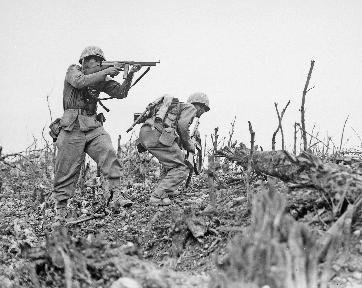Quiz Answer Key and Fun Facts
1. What did Guderian and his tank-minded German contemporaries regard as the most important characteristic of the tank?
2. During the Battle of France, June 5th-22nd 1940, Rommel's 7th Panzer Division established what world record?
3. On May 26th 1940 Maxime Weygand, who had taken over command of the French forces from Maurice Gamelin on 19th May, ordered what kind of defence for the Battle of France, which began on 5th June?
4. Put these four books into the order in which they were published: Charles de Gaulle, "Vers l'armèe de métier" ("On the army of the future"); J F C Fuller, "On Future Warfare"; Heinz Guderian, "Achtung - Panzer"; and Liddell Hart, "Paris, or the Future of War".
5. What was the closest French equivalent of the Panzer Division?
6. Fuller's Plan 1919 was for a full Allied breakthrough of the German front. What did he stipulate as the main enemy target for the Allied forces once the breakthrough had been achieved?
7. The first time that the famous German 88mm anti-aircraft gun was used in anything other than its intended role was at Arras on 21st May 1940 when they were fired in desperation against the heavily armoured British infantry tanks of Frankforce, which counterattacked Rommel's 7th Panzer Division, and whose armour the standard German 3.7cm PAK anti-tank gun couldn't penetrate.
8. Which country formed the first permanent brigade-sized tank formation?
9. What relation did the original German General Staff proposals for war against France and the Low Countries, issued on October 19th 1939, have to the German Schlieffen Plan used at the outset of WWI?
10. The German doctrine of "Auftragstaktik" was a vital ingredient in the success of their Blitzkrieg. It consisted of...
11. Up to 1917 Guderian was a specialist in what military branch?
12. What constructional feature most inhibited French tanks' combat effectiveness against their German opponents in 1940?
13. On 19th May 1940, which Allied commander first planned a pincer movement by French forces to the south of the German corridor and Allied forces to its north, in order to cut off the armoured spearheads from their supporting infantry?
14. The Belgian capture at Mechelen-sur-Meuse on Jan 10th of the German plan for the invasion of the Low Countries forced the Germans to completely revise it by using the Sichelschnitt idea.
15. He began his military career as an officer in the Tsarist army, and was captured by the Germans in 1915, sharing imprisonment in the same camp with de Gaulle. He escaped, and in 1918 joined the Bolshevik party. In 1920 he commanded the Red Army offensive which was on the point of surrounding and capturing Warsaw but which was smashed by a Polish counteroffensive very reminiscent of the Russian one at Stalingrad in 1942/43. Later in 1920 he captured Siberia from the rebel Alexander Kolchak and assisted in Denikin's defeat in the Crimea. From 1921 to 1923 he suppressed the Kronstadt rebellion and the Volga peasants' revolt, and from 1925 held successively the posts of chief of staff of the Revolutionary Committee of the Red Army, commander of the Leningrad military region and deputy People's Commissar for Defence. He was promoted Marshal of the Soviet Union in 1935; by this time he had become instrumental in the modernisation of the Red army. He developed the concept of "deep battle", in which combined arms including airpower and paratroops bring the full depth of enemy forces under attack through a four-stage process of breakthrough of his line and subsequent deep penetration. This doctrine was formalised in the Soviet Provisional Field Manual of 1936; it influenced western military thinkers, especially Guderian.
Who was he?
16. During the Polish campaign, Hitler came upon the remains of a smashed enemy artillery regiment. He asked a senior commander: "Our ______ did that?" The commander replied: "No, our ______". Hitler was impressed.
17. The Germans allocated 10 armoured/light divisions to Fall Gelb, the attack on France and the Low Countries. How many of these were allocated to the Low Countries?
18. The Germans outnumbered the Allies in May 1940 in only one of the following resources. Which one?
19. When the German Army High Command stopped Guderian's XXI Panzer Corps on the morning of 17th May 1940, Guderian obtained permission to resume the advance. How did he obtain that permission?
20. Who first thought of the Sichelschnitt ("sickle/scythe cut") idea that was to become the German plan for the assault on 10th May?
21. How many times was the German attack plan for war against France and the Low Countries postponed?
22. General Walter Wever, first Luftwaffe Chief of Staff, was killed in an air crash on 3rd June 1936 (http://www.feldgrau.com/luftorg.html). After his death, the Luftwaffe moved away from the concept that he had championed, and in a direction which resulted in a much closer relationship with the army, a direction which proved essential for the development of Blitzkrieg. What was the concept that died in the Luftwaffe with Wever?
23. When the German 1st Army finally attacked the Maginot Line head-on on 14th June 1940, it broke through in a few hours by a conventional infantry assault without tank support.
24. What was the first assault of WWI in which aircraft were specifically assigned to support the tanks?
25. Which country was the most advanced practitioner of airborne warfare (that is the use of paratroopers) in the interwar years?
Source: Author
anselm
This quiz was reviewed by FunTrivia editor
bloomsby before going online.
Any errors found in FunTrivia content are routinely corrected through our feedback system.

